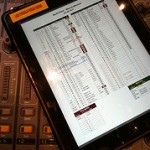
Missing My Tools
I had an interesting experience a couple weeks ago. I was back in Chicago for a few days, and the audio team at my former church was gracious enough to let me play around on their system using some of their rehearsal tracks to satisfy my curiosity on how that system sounds seven years after we did the original install. The system still sounded pretty good which is definitely a testament to Meyer Sound’s loudspeakers. The team also made some improvements to the sub configuration which was very cool to see and hear. But in the whole experience, the thing that struck me the most was how accustomed to and important having my own tools to mix has become.
I believe it’s important for any mix engineer to have a mastery of the fundamentals of mixing so they can walk into just about any situation and make it work with what’s there. However, I think there is also something to be said about carrying your own set of tools for the job, and it’s something I wish I had begun building much earlier in my career. We don’t expect a guitarist to show up needing a guitar or a painter needing brushes or a photographer needing a camera. A couple years ago I started wondering why I put myself in a position through most of my career where I’ve been reliant on someone else providing a set of tools for me with expectations I’m going to deliver a certain result. So over the last couple of years I’ve been liquidating some of my old band gear and slowly gathering a small collection of my own plugins for use in any mixing situation whether live or in the studio.
The thing about working in audio is there are a million ways to do the same thing, and a million different pieces of gear to get you there. But I’ve discovered over the years that there are certain pieces I gravitate towards more. These are simply pieces of gear that get me where I want to go faster than when I have something handed to me. These are also pieces that might fit a certain taste I have or that allow me to use specific mix techniques to achieve certain results. They’re things that I’m very familiar with that I can quickly apply in response to hearing certain things.
For example, over the last couple of years I’ve gotten more and more into using harmonic related plugins while mixing. These can be subtle tape-saturation simulator plugins such as the Cranesong Phoenix or Waves Kramer Master Tape. They might also be more aggressive like the Aphex Big Bottom or Waves MaxxBass and Renaissance Bass plugins. When I was playing with the rehearsal tracks in Chicago, I had a hard time getting the snare the weight I wanted it to have. If the band was there, I probably would have tried playing with mic placement. Since I was using tracks all I could do was look for a processor and these days I’d typically utilize a harmonic enhancing process to do this. But I didn’t have my plugins with me.
Similarly, there were things I was hearing with some tonal variations happening in some of the vocals where certain notes might have a slight resonance bugging me here and there. A simple EQ fix would have been too much for other parts of the song, but I knew if I’d had access to a Serato Dynamic EQ or my Waves C4 I could have quickly tamed what was bugging me.
Now some of this might be considered last 2% audio snobbery stuff, but it’s important for me because almost everything we do could be counted as a 2% gain and that all adds up. While I was reasonably satisfied with the results I could get given we were just playing around, it was also a little eye-opening to know what a difference having certain tools and in particular, my familiar set of tools, can make. I think this highlights one of the strengths in standardizing equipment across multiple venues within a facility so that your staff and volunteers can have a familiar set of tools to work with in any circumstance. But if you’re making a living at this, I also think you should look into developing your own tool chest.

 Previous Post
Previous Post Next Post
Next Post


